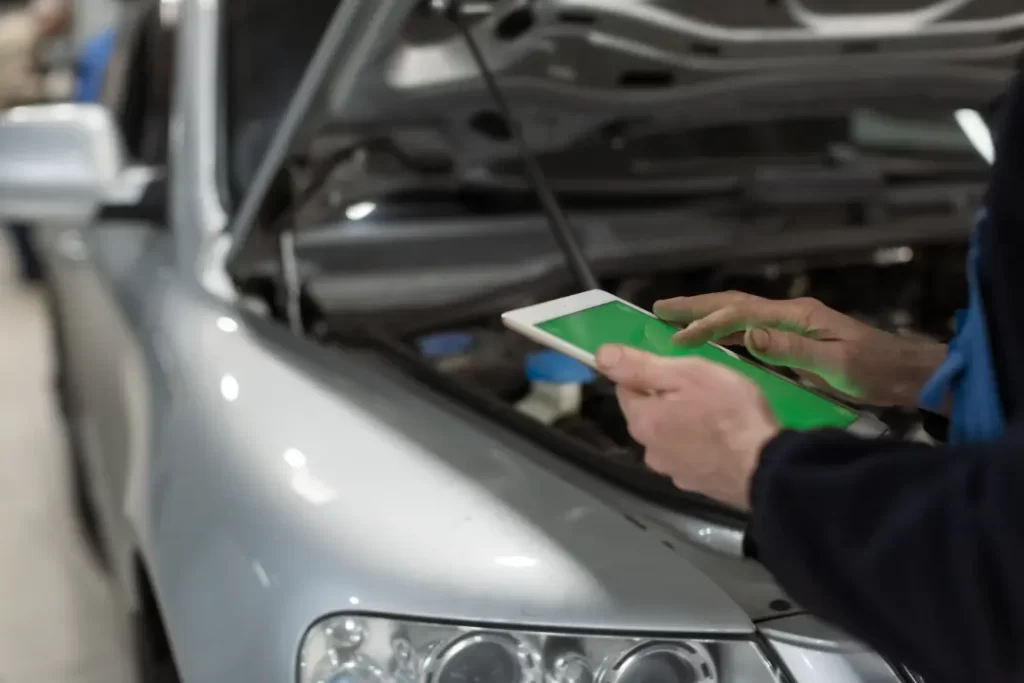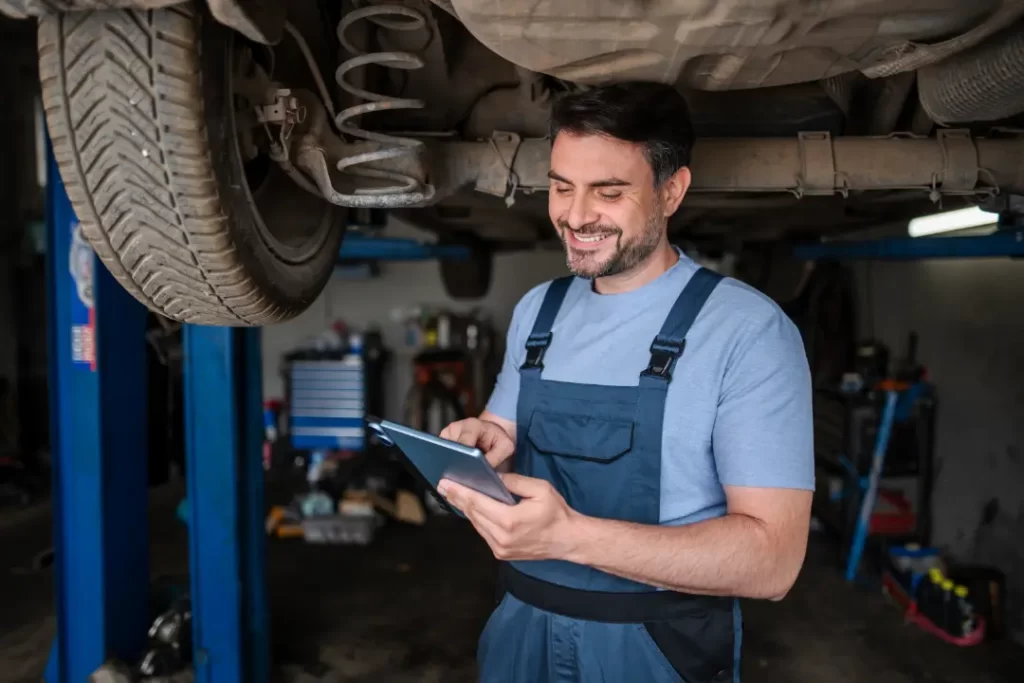Preparing for an MOT doesn’t have to be overwhelming. A few simple checks at home can save you the stress and cost of a failed test. Think about lights, tyres, fluid levels, and wipers. These small details can make a big difference when it comes to passing on the first try.
In this guide, we’ll walk you through the most important things to check before the big day, along with tips that can give your vehicle the best chance of passing its MOT.
A little preparation now can lead to a smoother, cheaper, and much less stressful experience later.
Key Takeaways
- Perform essential pre-MOT checks on lights, tyres, brakes, and the windscreen to boost your chances of passing.
- Regularly check engine fluids and ensure all safety features, such as seatbelts and mirrors, are functional to comply with MOT regulations.
- Choose a reputable garage like Ivydene Garage Ltd. for trustworthy MOT services and repairs, thanks to their proven expertise and comprehensive offerings.
- Suspension, steering, and exhaust systems should be inspected to ensure safety and compliance.
- Minor bodywork issues, sharp edges, or cracked mirrors can result in MOT problems if overlooked.
Essential Pre-MOT Checks
Thorough pre-MOT checks before visiting the test centre can significantly reduce the risk of failure. Focus on key areas such as:
- Lights
- Tyres
- Brakes
- Windscreen
This helps identify common issues such as faulty wiper blades, insufficient tread depth, and non-functional bulbs.
Addressing these elements increases the likelihood of passing the MOT, ensuring safe driving and legal compliance.

Lights and Indicators
Your car’s lights do more than help you see the road. They are vital for keeping you and other drivers safe. During an MOT, every light on your vehicle gets checked, from headlights to brake lights.
It’s a good idea to do a quick test at home. Press the brake pedal and either have someone watch from behind or back up to a reflective surface to ensure they are working properly.
Don’t overlook the smaller details, like your dashboard warning lights. All these should light up briefly when you start the ignition, showing that the system is working correctly. And one that many drivers miss is the number plate light. A simple blown bulb here can lead to an MOT fail, but it’s an easy and cheap fix if you catch it early.
Tyres and Wheels
Your tyres are the only part of your car that touches the road. Their condition is one of the most important safety checks before an MOT. To pass, the tread depth needs to be at least 1.6mm across the central three-quarters of the tyre.
Anything less will result in an instant fail. Keeping them properly inflated is important for both safety and fuel efficiency.
It’s also a good idea to inspect each tyre closely. Lumps, bulges, or cracks in the rubber can indicate hidden damage that may compromise safety. This damage could lead to your vehicle being pulled over during the test.
If your car has a tyre pressure monitoring system, ensure it’s working correctly. This system adds an extra layer of protection and peace of mind on the road.
Brakes and Brake Pedal
Your brakes are one of the most important safety systems in your car, making them a crucial part of the MOT. Worn brake pads or discs are common reasons for failure, so checking them in advance is a good idea.
If you notice the car pulling to one side while braking, that indicates an issue that needs fixing before test day.
Don’t overlook the handbrake. It should hold the vehicle securely on an incline. If it doesn’t, that clearly means it needs adjustment.
Windscreen and Wipers
A clear view of the road is essential, which is why the MOT closely examines your windscreen and wipers. Damage larger than 10mm in the driver’s direct line of sight can lead to failure; therefore, address small chips and cracks promptly.
Your wipers should move smoothly and clear the screen effectively without leaving streaks.
Also, don’t forget the screenwash. If the washer jets can’t spray fluid, that alone can result in a failed test, so ensure it’s filled up before you go.
Engine and Fluid Levels
Regularly check the engine and fluid levels to avoid MOT rejections and ensure smooth vehicle operation. These checks help pass the MOT test and maintain the overall health of your vehicle.
Pay attention to essential fluids, such as engine oil, coolant, brake fluid, and power steering fluid.
Engine Oil and Fluids
Check the levels of the following fluids before the MOT:
- Engine oil: Use the dipstick to ensure the oil level falls between the minimum and maximum marks.
- Coolant
- Brake fluid
- Power steering fluid
Inadequate fluid levels can lead to MOT failure and impact vehicle safety and performance.
Fuel System and Fuel Cap
Check the fuel system for damage and ensure the fuel cap closes properly to prevent leaks and evaporation. A damaged fuel system can lead to significant issues during the MOT.
Make sure the fuel cap is secure and compliant with safety standards.
Exhaust System and Emissions
The exhaust system plays a vital role in controlling vehicle exhaust emissions, which is crucial for passing the MOT. Make sure the exhaust system is intact, free from excessive rust or damage, and securely mounted.
Meeting emission standards is necessary to avoid failure.
Exhaust Condition
Listen for excessive noise or rattling from the exhaust, which can indicate underlying problems. Passing the MOT requires an intact exhaust system. Emission standards must also be met.
Emission Levels
Vehicles must meet specific manufacturer-set emission limits to pass the MOT. A malfunctioning engine light can signal potential issues that may lead to high emissions.
Ensure your vehicle’s test emission levels comply with the correct standards to avoid failure.
Steering and Suspension
Proper steering systems ensure smooth handling. Suspension systems also play a key role in ensuring vehicle safety. Regular inspections of these components are crucial. These components greatly influence vehicle stability and comfort.
These systems must be in good condition to pass the MOT.
Steering Components
Check steering components for signs of wear or damage. A well-maintained steering wheel is crucial for safe vehicle operation. It ensures the driver’s control over the vehicle.
Ensure the power steering system is functioning properly. This maintains safe driving conditions.
Suspension and Shock Absorbers
Check the shock absorbers for leaks. Ensure they are securely fastened. Check suspension components for signs of wear and verify they are properly fastened to the vehicle.
A well-maintained suspension system ensures a smooth ride and passing the MOT.
Bodywork and Visibility
Your vehicle’s bodywork must be in good condition to pass the MOT. Inspect for sharp edges, excessive corrosion, and visible signs of damage.
Damaged windscreens or faulty windscreen wipers can lead to MOT failures.
Car Bodywork
Examine the car’s bodywork for sharp edges and excessive corrosion. Check for significant dents as well.
The bodywork plays a crucial role in ensuring safety during the MOT test, as it has been tested for compliance.
Ensure all panels are securely fitted and meet safety standards.
Mirrors and Windscreen
Ensure all vehicle mirrors are intact and securely attached. They must provide a clear view from the driver’s seat of the road. Mirrors should be free of cracks or damage that hinders visibility.
A clear windscreen is essential; any significant damage larger than 10mm in the driver’s view can lead to an MOT failure.
Interior and Safety Features
All interior safety features must function correctly for safe driving. Dangerous faults require immediate repairs and render the vehicle unroadworthy.
These checks help guarantee safety and compliance with MOT test regulations.
Seat Belts and Seats
Check the following to ensure safety and proper function:
- Seat belts for fraying or cuts.
- Ensure seat belts engage properly by pulling sharply to test the locking.
- Ensure the driver’s seat adjusts smoothly and freely.
- Confirm the driver’s seat locks securely in place to prevent movement while driving.
These checks are crucial for passenger safety and passing the MOT.
Dashboard Warning Lights
Make sure all dashboard warning lights are off. If any remain illuminated, fix the issues or have your car checked before the test.
Verify that all dashboard warning lights illuminate and function correctly during ignition to ensure the vehicle’s safety and optimal performance.
Documentation and Identification
Proper documentation prevents discrepancies during the MOT test. Have the current MOT certificate and the V5C registration document to avoid delays.
Documentation discrepancies can lead to complications and possible failure during the MOT.
Vehicle Identification Number (VIN)
The Vehicle Identification Number (VIN) must be clearly visible for compliance during the MOT process. The VIN should be prominently displayed on the vehicle for proper identification.
The VIN must match both the bodywork of the vehicle and the provided documentation.
MOT Certificate and V5C Document
You will need specific documents for the MOT test. These include the V5C registration document and the current MOT certificate. Correct documentation ensures a smooth MOT process. It helps avoid potential delays.
If lost, the V5C document can be replaced online. This can be done through the DVLA using the vehicle’s registration and VIN.
What to Do If Your Car Fails Its MOT
An MOT failure isn’t the end of the world, but what happens next depends on the type of fault recorded. Issues are categorised into three groups: minor, major, and critical.
Dangerous faults mean the car is unsafe to drive; you’ll need to get it repaired before it can go back on the road.
Major faults also need fixing before your vehicle can pass the MOT, but you may be able to take the car to another garage for repairs if it’s still considered roadworthy.
Minor faults, on the other hand, won’t cause you to fail the test, but they should still be addressed quickly to keep your car safe and reliable.
Interestingly, almost half of MOT failures result from simple maintenance oversights, such as blown bulbs, worn wipers, or low fluid levels. Staying on top of these small checks could save you time, money, and frustration from a failed test.

Repair Options and Retesting
If your vehicle does not pass its MOT, follow these steps:
- Have repairs done at the original testing centre.
- Complete these repairs within ten working days to qualify for a partial retest.
- Confirm with your MOT tester whether all repairs qualify for partial retests.
Regular maintenance can prevent these issues, keeping your vehicle roadworthy and compliant with safety standards.
Why Choose Ivydene Garage Ltd. for Your MOT Needs
When you need your MOT, picking the right garage is essential. At Ivydene Garage Ltd., you aren’t just scheduling a test; you’re placing your vehicle in the care of a trusted, family-run business that has served Ashford drivers since 1981.
With over 40 years of experience, we’ve built a reputation for reliable, professional car servicing care that keeps our customers returning year after year.
Trusted Expertise and Bosch Accreditation
We conduct our MOTs and repair work to the highest standards, backed by decades of experience and our status as a Bosch Car Service centre. This gives you the confidence of service and diagnostics equivalent to that of the manufacturer, combined with the friendly, personal touch of a local, family-run team.
Whether it’s your annual MOT, complex diagnostics, or routine vehicle maintenance, you can trust us to take expert care of your car.
A Convenient One-Stop Solution
Ivydene Garage, located right here in Ashford, is designed to make life easier for drivers. We offer everything under one roof, from MOT testing and clutch replacements to tyres, servicing, and air conditioning checks.
Instead of dealing with different garages for different services, you can count on us as your one-stop solution for keeping your vehicle safe, roadworthy, and performing at its best.
Frequently Asked Questions
What should I check before my MOT test?
Before your MOT test, make sure to check your lights, tyres, brakes, and windscreen, along with fluid levels. Don’t forget to have your documentation ready, too!
What are the common reasons for MOT failures?
MOT failures often happen due to faulty lights, worn-out tyre tread, brake problems, and windscreen damage. Make sure to check these areas before your next test!
How can I ensure my vehicle passes the MOT test?
To ensure your vehicle passes the MOT test, perform thorough pre-MOT checks and address any issues you find while keeping up with regular servicing. This proactive approach can save you time and hassle!
What happens if my car fails the MOT?
If your car fails the MOT, you’ll need to fix the problems highlighted and potentially do so right away, depending on their severity. Make sure to address those issues promptly to get back on the road safely!
Why should I choose Ivydene Garage Ltd. for my MOT needs?
You should choose Ivydene Garage Ltd. for your MOT needs because we provide expert testing and have a solid reputation for quality service you can trust. It’s a smart move for your car’s maintenance!
Conclusion
Conducting thorough pre-MOT checks can significantly reduce the risk of MOT failure and ensure your vehicle remains safe and roadworthy. Focus on key areas such as lights, tyres, brakes, and windscreen, and ensure all documentation is in order.
If your vehicle does fail, understanding the failure categories and knowing your repair options can help you get back on the road quickly. Choose Ivydene Garage Ltd. for expert MOT testing and comprehensive automotive care.
